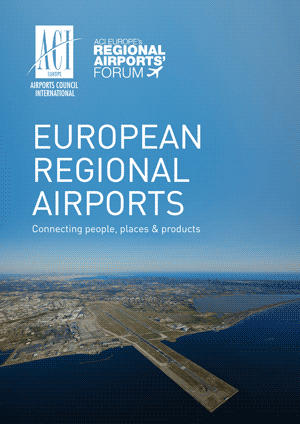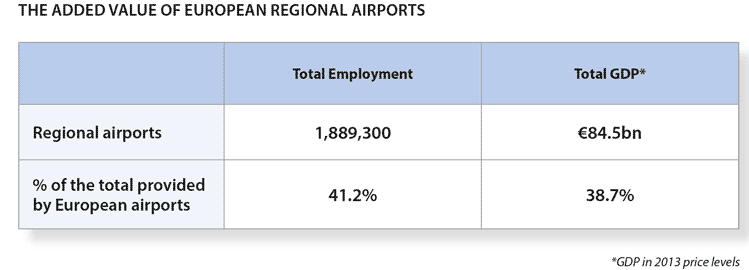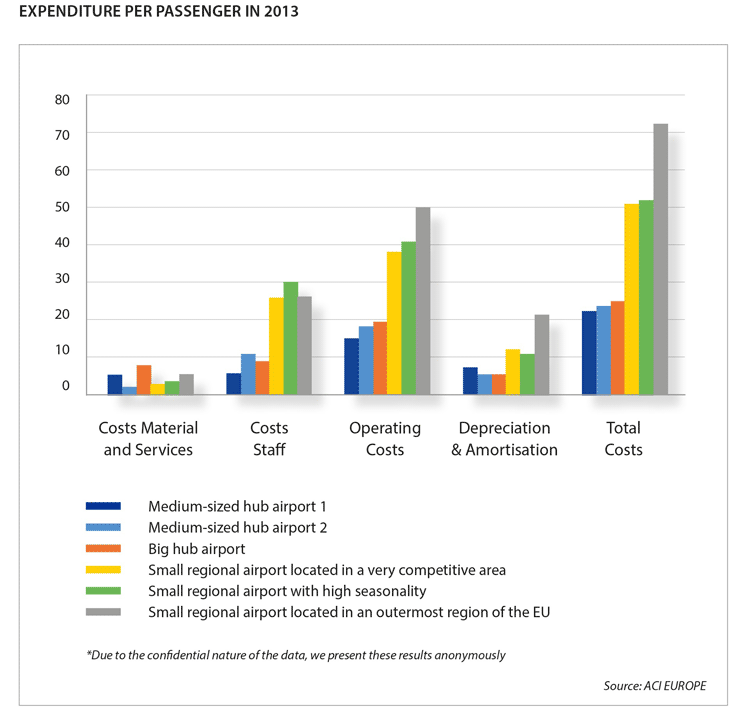In Europe, 466 regional airports in 44 countries are ACI EUROPE’s members. These airports play a pivotal role in strengthening Europe’s air connectivity and national economies. They represent 91.7% of the European airport network, with 209 carriers and 14,600 routes to 724 destinations in 2017. Federico Bonaudi spells out the value these airports bring, in ACI EUROPE’s latest publication “European Regional Airports – Connecting People, Places & Products.”

Niall MacCarthy, Vice-Chair ACI EUROPE’s Regional Airports Forum & CEO Cork Airport; Henri Hansson, Chair ACI EUROPE’s Regional Airports Forum & Senior Vice President Finavia; and Federico Bonaudi, ACI EUROPE Facilitation, Parliamentary Affairs & Regional Airports Manager, presenting the new ACI EUROPE publication on European Regional Airports in Rovianemi.
For more than 10 years, ACI EUROPE’s Regional Airports’ Forum has provided a platform for smaller and regional airports to exchange knowledge, share best practices and discuss issues of common interest, making their voice heard and their specificities recognised – especially in all aviation related policies and regulatory issues.
A unique network of more than 450 regional airports (91.7% of the total membership of the association), the Forum gives ACI EUROPE an in-depth knowledge of the issues and interests specific to their environment.

The new ACI EUROPE publication on European Regional Airports – Connecting People, Places & Products was released at the 26th ACI EUROPE Regional Airports’ Forum meeting on 20 November in Rovianemi. The document can be downloaded here.
In order to give more visibility to the role played by European regional airports and to react with well-founded and accurate data against some of the voices that have questioned the pertinence of regional airports, ACI EUROPE decided to produce a dedicated analysis study on European Regional Airports – Connecting People, Places & Products.
Released at the 26th ACI EUROPE Regional Airports’ Forum meeting on 20 November in Rovianemi (Finland), this publication stresses the economic and social benefits of regional airports and gives an overview of the most important challenges and regulatory requirements facing them. It also underlines the contribution of the ACI EUROPE Regional Airports’ Forum to the discussion on the importance of regional airports in Europe.
The importance and benefits of regional airports in Europe
European regional airports play a key role in supporting an efficient and well-functioning European transport network, facilitating trade and ensuring mobility for a greater number of people. This network does much more than complementing the high-speed rail network: it provides accessibility to the most remote areas and therefore access to essential services, and supports economic and social integration, local development and retention of residents.
With 209 operating carriers, 14,600 routes and 724 destinations, annual traffic has increased by 173% since the liberalisation of air traffic rights in the early 90s. Moreover, direct connectivity at regional airports has increased by almost 40% in the last 10 years. Today, regional airports handle in excess of 800 million passengers each year!
As a result, along with their larger counterparts, regional airports are now defining the economies of their communities, being true catalysts for economic regeneration and growth: 1,889,300 direct, indirect and induced jobs are created by regional airports, with a contribution of €84.5 billion to the European economy.
Main challenges facing regional airports in Europe
Without a shadow of a doubt, the biggest challenge facing regional airports is managing high operating and fixed costs, CAPEX and maintenance, due to very limited economies of scale. Airports have to provide minimum equipment and staff to handle traffic at any time during operating hours, which means that the costs of human resources, provision, operation and maintenance occur even without a single flight: capacity (and not traffic) is therefore the main trigger of costs/expenses.

Increasing and more stringent regulatory requirements, airline pressure and limited European funding also play a very important role in the cost structure of regional airports. The total costs per passenger may in some cases triple those of bigger hubs.
Since growth is not guaranteed on a linear basis, regional airports need to manage their costs very effectively. In the past, it was possible for shareholders to compensate any financial gaps by additional capital injections, but this type of support is very limited nowadays. The main area for potential savings is a very strict asset management approach limiting the risk of over-capacity leading to high unproductive costs. Another area that needs to be investigated in more detail is the possibility of savings by cooperating with other airports.
As regional airports operate in a highly competitive market with a downward pressure on aeronautical charges, increasing commercial revenues plays a vital role. It is a well-established fact that retail, F&B, car rental, car parking, advertising and real estate are a core element of airports’ income. It is generally the case also that smaller airports do not have the same commercial revenue generating opportunities as their larger counterparts: passenger profile is different and the customer base is smaller in volume.
Convincing an airline to establish a new air service to/from a regional airport can be a demanding and lengthy process. Negotiating with these powerful carriers and alliances remains another key challenge. Recent market developments show that air traffic growth has been predominantly driven by LCCs that exercise considerable pressure on regional airports and recently seek to move upmarket, occasionally abandoning or reducing capacity at some of their “traditional” bases at regional airports.

For regional airports, increasing the number of destinations served and attracting more passengers and cargo through the development of their route network and the diversifications of their airline portfolio is a core business imperative: liberalising market access on international routes and achieving regulatory convergence are the keys to achieve this.
Several EU Member States have introduced or plan to implement specific aviation taxes at national level. Evidence suggests that the economic impact of the taxes on the economy as a whole largely outweighs the expected return from the tax: they discourage travel, reduce the connectivity of the regions, lead to job suppression, damage the European economy as a whole and put the sector at a competitive disadvantage with other world regions.
Finally, the multiple layers of European legislation are difficult to implement for regional airports in a cost-effective manner. Legislation does not have the same economic impact on hubs and regional airports, the latter being less well-staffed and resourced to deal with the regulatory avalanche. ACI EUROPE and its Regional Airports Forum have been advocating the “one-size-does-not-fit-all” approach. While European policy-makers have often recognised the importance and the specific nature of regional airports as well as the needs stemming from them, this has not always been reflected to the full extent possible in the legislation.







